The Vegetable Glycerin Market is estimated to be valued at USD 1.5 billion in 2025 and is projected to reach USD 2.6 billion by 2035, registering a compound annual growth rate (CAGR) of 5.3% over the forecast period.
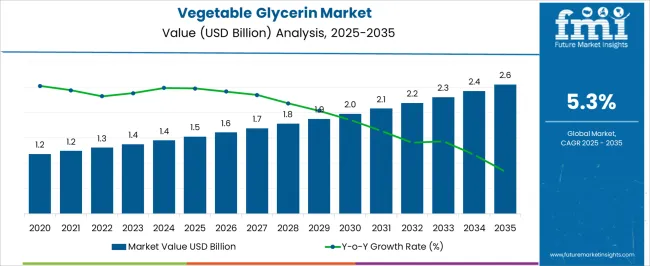
| Metric | Value |
|---|---|
| Vegetable Glycerin Market Estimated Value in (2025 E) | USD 1.5 billion |
| Vegetable Glycerin Market Forecast Value in (2035 F) | USD 2.6 billion |
| Forecast CAGR (2025 to 2035) | 5.3% |
The Vegetable Glycerin market is experiencing steady growth, driven by increasing demand across personal care, pharmaceutical, and industrial applications. Rising consumer awareness regarding natural and sustainable ingredients is supporting adoption in cosmetics, skincare, and hygiene products. The market is further fueled by the versatility of vegetable glycerin, which functions as a humectant, solvent, and emollient, providing multiple benefits across formulations.
Growth in the industrial sector, including use in food processing, beverages, and chemical production, is contributing to market expansion. Technological advancements in extraction and purification processes are enhancing product quality and consistency, enabling broader application in regulated industries. Increasing investments in research and development to improve formulation stability and efficacy are creating additional opportunities.
Regulatory compliance with environmental and safety standards has also encouraged the adoption of vegetable glycerin as a preferred alternative to synthetic glycerin As consumer demand for natural and multifunctional ingredients continues to rise, the market is expected to sustain long-term growth, driven by both personal care and industrial applications.
The vegetable glycerin market is segmented by source, grade, application, and geographic regions. By source, vegetable glycerin market is divided into Soy Oil, Palm Oil, Coconut Oil, Others, and Grape Seed. In terms of grade, vegetable glycerin market is classified into Industrial Grade, Pharma Grade, and Food Grade. Based on application, vegetable glycerin market is segmented into Personal Care, Cosmetics, Food And Beverages, and Medicines. Regionally, the vegetable glycerin industry is classified into North America, Latin America, Western Europe, Eastern Europe, Balkan & Baltic Countries, Russia & Belarus, Central Asia, East Asia, South Asia & Pacific, and the Middle East & Africa.
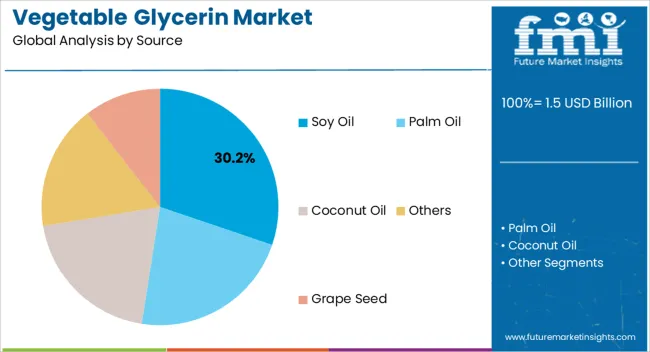
The soy oil source segment is projected to hold 30.2% of the market revenue in 2025, establishing it as the leading source of vegetable glycerin. Its prominence is being driven by wide availability, cost efficiency, and high glycerin yield, making it suitable for both industrial and personal care applications. Soy oil-derived glycerin is favored due to its consistent quality and compatibility with diverse formulations, providing enhanced solubility and stability.
Adoption is further supported by ongoing advancements in extraction and refinement processes that ensure high purity levels. Environmental sustainability and renewable sourcing of soy oil are also contributing factors, aligning with consumer preference for eco-friendly ingredients.
The segment’s ability to serve multiple end-use industries, coupled with strong supply chain infrastructure and scalability, strengthens its leadership position As the demand for natural and versatile glycerin continues to grow across global markets, the soy oil source segment is expected to maintain its market dominance, supported by technological improvements and sustainable sourcing practices.
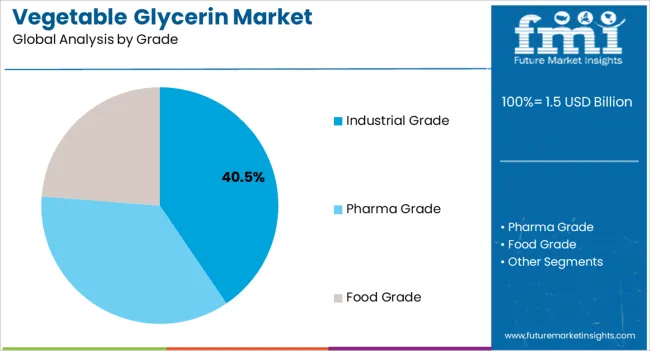
The industrial grade segment is anticipated to account for 40.5% of the market revenue in 2025, making it the largest grade category. Growth in this segment is being driven by extensive use in manufacturing, food processing, pharmaceuticals, and chemical production where high-purity glycerin is required for functional and regulatory compliance. Industrial grade vegetable glycerin provides cost-effective performance for large-scale applications and is preferred for its consistency and versatility.
Continuous improvements in processing techniques have enhanced product stability, reducing impurities and ensuring reproducible quality. Rising demand for eco-friendly and biodegradable chemicals in industrial processes has further supported adoption.
Manufacturers benefit from scalability, reliability, and ease of integration into production workflows As industrial applications continue to expand with growing global manufacturing and processing activities, the industrial grade segment is expected to remain the primary contributor to market revenue, driven by efficiency, performance, and regulatory compliance advantages.
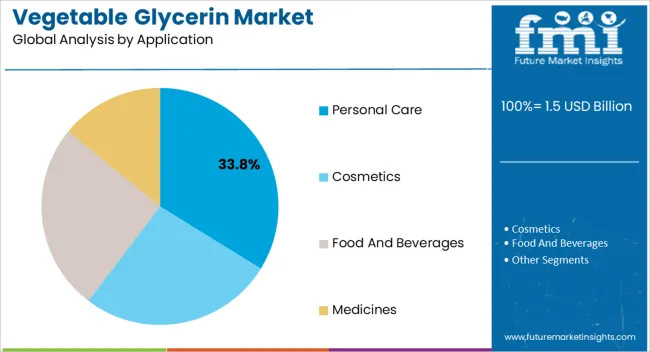
The personal care application segment is expected to account for 33.8% of the market revenue in 2025, establishing it as the leading application. Growth in this segment is being driven by increasing consumer demand for natural and safe ingredients in cosmetics, skincare, hair care, and oral hygiene products. Vegetable glycerin functions as a humectant, moisturizer, and solvent, enhancing product efficacy and texture while providing skin-friendly properties.
Rising trends in organic and eco-conscious personal care products have further boosted adoption. Its compatibility with diverse formulations allows manufacturers to develop innovative products targeting sensitive skin and wellness-conscious consumers.
Regulatory compliance and safety standards are reinforcing its preference over synthetic alternatives As the global beauty and personal care market continues to expand, the personal care segment is expected to remain a key driver of vegetable glycerin demand, supported by multifunctionality, product performance, and consumer preference for sustainable, natural ingredients.
According to the research of Future Market Insights, the market for Vegetable Glycerin is anticipated to expand at a CAGR of 5.3% over the forecasted time period. According to projections, the industry would be worth US$ 2,190.0 Million by 2035, up from US$ 1,306.6 Million in 2025. At the end of 2025, the Vegetable Glycerin Market has valued at US$ 1,245.6 Million.
| Attributes | Details |
|---|---|
| Market Size Value in 2025 | US$ 1,306.6 Million |
| Market Forecast Value in 2035 | US$ 2,190.0 Million |
| Global Growth Rate (2025 to 2035) | 5.3% |
| Forecast Period | 2025 to 2035 |
| Global Market Share of USA, Germany, Japan, and Australia | 69.9% |
Vegetable oil is heated to a very high temperature while being compressed under water pressure to produce the natural product known as Vegetable Glycerin. Vegetable Glycerin has a sweet flavour and is odourless, and colourless.
The main markets for Vegetable Glycerin are Food and Beverage, Cosmetics, and Pharmaceuticals. Vegetable Glycerin is frequently used in skin care products to make skin moist and healthy, and it is also utilised as a sugar substitute or sweetener in the food and beverage sector. In terms of value and volume, North America and Western Europe are anticipated to increase their market shares the most.
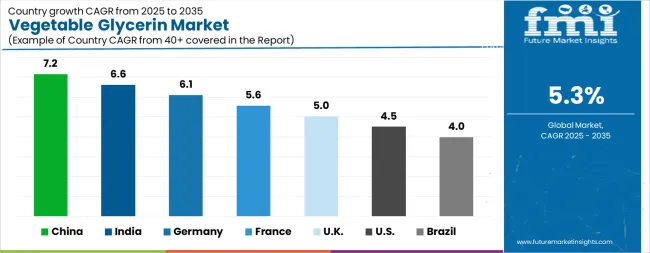
| Country | CAGR |
|---|---|
| China | 7.2% |
| India | 6.6% |
| Germany | 6.1% |
| France | 5.6% |
| UK | 5.0% |
| USA | 4.5% |
| Brazil | 4.0% |
The Vegetable Glycerin Market is expected to register a CAGR of 5.3% during the forecast period, exhibiting varied country level momentum. China leads with the highest CAGR of 7.2%, followed by India at 6.6%. Developed markets such as Germany, France, and the UK continue to expand steadily, while the USA is likely to grow at consistent rates. Brazil posts the lowest CAGR at 4.0%, yet still underscores a broadly positive trajectory for the global Vegetable Glycerin Market. In 2024, Germany held a dominant revenue in the Western Europe market and is expected to grow with a CAGR of 6.1%. The USA Vegetable Glycerin Market is estimated to be valued at USD 562.5 million in 2025 and is anticipated to reach a valuation of USD 873.9 million by 2035. Sales are projected to rise at a CAGR of 4.5% over the forecast period between 2025 and 2035. While Japan and South Korea markets are estimated to be valued at USD 73.8 million and USD 43.0 million respectively in 2025.
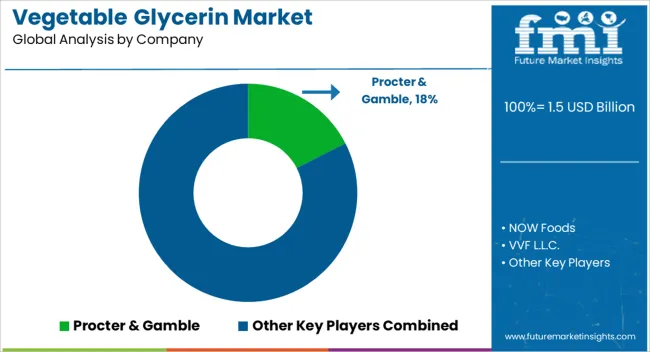
| Item | Value |
|---|---|
| Quantitative Units | USD 1.5 Billion |
| Source | Soy Oil, Palm Oil, Coconut Oil, Others, and Grape Seed |
| Grade | Industrial Grade, Pharma Grade, and Food Grade |
| Application | Personal Care, Cosmetics, Food And Beverages, and Medicines |
| Regions Covered | North America, Europe, Asia-Pacific, Latin America, Middle East & Africa |
| Country Covered | United States, Canada, Germany, France, United Kingdom, China, Japan, India, Brazil, South Africa |
| Key Companies Profiled | Procter & Gamble, NOW Foods, VVF L.L.C., Cargill, Incorporated, Dutch Glycerin Refinery (DGR), The Dow Chemical Company, Parchem fine & specialty chemicals, Avril Group, and Essential DepotInc. |
The global vegetable glycerin market is estimated to be valued at USD 1.5 billion in 2025.
The market size for the vegetable glycerin market is projected to reach USD 2.6 billion by 2035.
The vegetable glycerin market is expected to grow at a 5.3% CAGR between 2025 and 2035.
The key product types in vegetable glycerin market are soy oil, palm oil, coconut oil, others and grape seed.
In terms of grade, industrial grade segment to command 40.5% share in the vegetable glycerin market in 2025.






Our Research Products

The "Full Research Suite" delivers actionable market intel, deep dives on markets or technologies, so clients act faster, cut risk, and unlock growth.

The Leaderboard benchmarks and ranks top vendors, classifying them as Established Leaders, Leading Challengers, or Disruptors & Challengers.

Locates where complements amplify value and substitutes erode it, forecasting net impact by horizon

We deliver granular, decision-grade intel: market sizing, 5-year forecasts, pricing, adoption, usage, revenue, and operational KPIs—plus competitor tracking, regulation, and value chains—across 60 countries broadly.

Spot the shifts before they hit your P&L. We track inflection points, adoption curves, pricing moves, and ecosystem plays to show where demand is heading, why it is changing, and what to do next across high-growth markets and disruptive tech

Real-time reads of user behavior. We track shifting priorities, perceptions of today’s and next-gen services, and provider experience, then pace how fast tech moves from trial to adoption, blending buyer, consumer, and channel inputs with social signals (#WhySwitch, #UX).

Partner with our analyst team to build a custom report designed around your business priorities. From analysing market trends to assessing competitors or crafting bespoke datasets, we tailor insights to your needs.
Supplier Intelligence
Discovery & Profiling
Capacity & Footprint
Performance & Risk
Compliance & Governance
Commercial Readiness
Who Supplies Whom
Scorecards & Shortlists
Playbooks & Docs
Category Intelligence
Definition & Scope
Demand & Use Cases
Cost Drivers
Market Structure
Supply Chain Map
Trade & Policy
Operating Norms
Deliverables
Buyer Intelligence
Account Basics
Spend & Scope
Procurement Model
Vendor Requirements
Terms & Policies
Entry Strategy
Pain Points & Triggers
Outputs
Pricing Analysis
Benchmarks
Trends
Should-Cost
Indexation
Landed Cost
Commercial Terms
Deliverables
Brand Analysis
Positioning & Value Prop
Share & Presence
Customer Evidence
Go-to-Market
Digital & Reputation
Compliance & Trust
KPIs & Gaps
Outputs
Full Research Suite comprises of:
Market outlook & trends analysis
Interviews & case studies
Strategic recommendations
Vendor profiles & capabilities analysis
5-year forecasts
8 regions and 60+ country-level data splits
Market segment data splits
12 months of continuous data updates
DELIVERED AS:
PDF EXCEL ONLINE
Vegetable Seed Market Size and Share Forecast Outlook 2025 to 2035
Vegetable Sugar Market Size and Share Forecast Outlook 2025 to 2035
Vegetable Parchment Paper Market Size, Share & Forecast 2025 to 2035
Vegetable Shortening Market Trends and Forecast 2025 to 2035
Vegetable Dicing Machines Market Growth – Food Processing Efficiency 2025 to 2035
Vegetable Carbon Market Trends - Functional Uses & Industry Demand 2025 to 2035
Vegetable Powders Market Insights - Growth & Functional Benefits 2025 to 2035
Vegetable Concentrates Market Growth - Nutrient-Dense Foods & Industry Demand 2025 to 2035
Vegetable Sorting Machine Market Analysis by Processing Capacity, Technology, Operation Type, Vegetable Type, and Region Through 2035
Vegetable Waste Products Market
IQF Vegetables Market Size and Share Forecast Outlook 2025 to 2035
Fresh Vegetables Market Size and Share Forecast Outlook 2025 to 2035
Frozen Vegetable Market Analysis - Size, Share, and Forecast Outlook 2025 to 2035
Brined Vegetable Market Analysis by Nature, Type, End-use, Distribution Channel and Region through 2035
Savory Vegetable Flavours Market Insights - Applications & Industry Growth 2025 to 2035
Canned Vegetable Market Growth – Preservation & Industry Demand 2024-2034
Textured Vegetable Protein Market Size and Share Forecast Outlook 2025 to 2035
Upcycled Vegetable Snacks Market Size and Share Forecast Outlook 2025 to 2035
Fruit And Vegetable Juice Market Size and Share Forecast Outlook 2025 to 2035
Fruit and Vegetable Ingredient Market Size and Share Forecast Outlook 2025 to 2035

Thank you!
You will receive an email from our Business Development Manager. Please be sure to check your SPAM/JUNK folder too.
Chat With
MaRIA